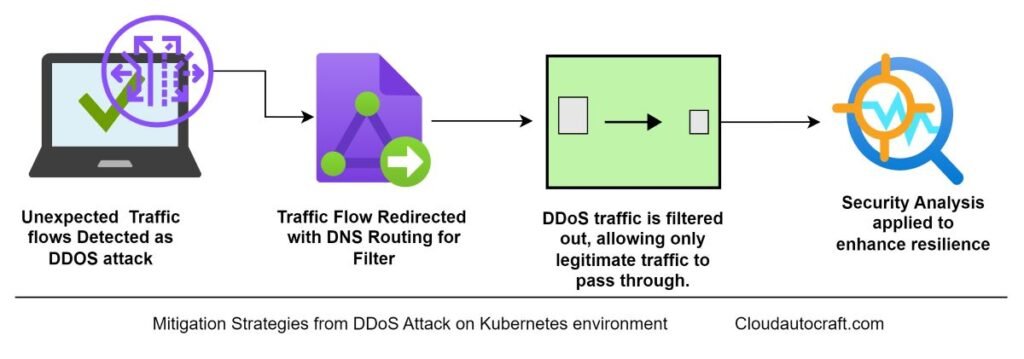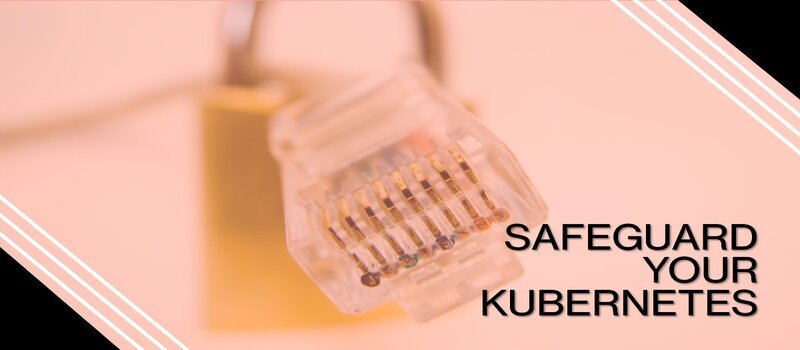Content:
- Introduction
- Understanding DDoS Attack on Kubernetes
- Effective Solutions to Mitigate DDoS Attack on Kubernetes
- Robust Network Policies of DDoS Attack on Kubernetes:
- Scaling and Load Balancing:
- Monitoring and Alerting of DDoS Attack on Kubernetes:
- Securing the Kubernetes API Server:
- DDoS Mitigation Services of DDoS Attack on Kubernetes:
- Chaos Engineering Practices for DDoS Attack on Kubernetes:
- Secure the Kubernetes Ecosystem:
- Conclusion: Protect DDoS Attack on Kubernetes
- FAQs:
- What are the main types of DDoS Attack on Kubernetes clusters?
- How can organizations proactively protect their DDoS attack on Kubernetes environments?
- What are some effective mitigation strategies for ongoing DDoS attack on Kubernetes?
- How can organizations test and validate the resilience of their Kubernetes environments against DDoS threats?
Introduction
Kubernetes is a popular choice for running containerized applications. However, its popularity also makes it a target for malicious actors. The Distributed Denial-of-Service (DDoS) attack is among the most common attacks in the Kubernetes environment. DDoS attacks flood a system with excessive requests, causing it to crash and not handle legitimate traffic. This blog post will discuss how to protect your Kubernetes while DDoS Attack on Kubernetes: What’s the Best Solutions! Therefore, We’ll share the best strategies to keep your applications running smoothly and your cluster secure. Stay tuned for practical tips and solutions!
Understanding DDoS Attack on Kubernetes
What is a DDoS Attack?
A DDoS (Distributed Denial of Service) attack happens when many computers work together to flood a website or server with too much traffic, causing it to crash. The goal is simple: to make the target, whether a system, service, or network, unusable for its intended users.
Here’s how it works: An attacker usually controls a network of compromised devices, known as a “botnet.” Moreover, These devices can be anything from personal computers to Internet of Things (IoT) gadgets that have been infected with malware. Then, they bombard the target with a flood of requests or traffic.
As a result, this flood drains the target’s resources—like bandwidth, memory, or processing power—causing it to crash or become unresponsive.
Why are Kubernetes Clusters Targeted?
Attackers often target Kubernetes clusters for several reasons:
- First, disrupting Kubernetes can severely affect organizations, making it a high-value target.
- In addition, Kubernetes is widely used to manage critical applications, making it an attractive target.
- Moreover, Kubernetes clusters can be vulnerable to security issues if misconfigured.
Common Weaknesses in Kubernetes
Here are some common weaknesses in Kubernetes that you should be aware of:
- Firstly, Kubernetes often comes with insecure default settings prioritizing ease of use over solid security. Hence, If you don’t review and adjust these default configurations, you risk leaving your cluster open to exploitation.
- On the other hand, the Kubernetes management and communication APIs can be prime targets for attackers if you don’t correctly restrict and secure access. So, Be careful about who can interact with these critical interfaces.
- Furthermore, examine your network policies within the Kubernetes environment closely. In fact, Weak network segmentation, overly permissive ingress and egress rules, and unprotected communication between your pods can all serve as handy entry points for attackers.
Overall, By addressing these common Kubernetes weaknesses, you’ll be in a much better position to defend your cluster against potential attacks. Therefore, It’s all about striking the right balance between usability and airtight security.
Effective Solutions to Mitigate DDoS Attack on Kubernetes
Here, All steps are defined for your best Effective Solutions to Mitigate DDoS Attacks on Kubernetes:

Robust Network Policies of DDoS Attack on Kubernetes:
- To illustrate, You should create network policies that control the traffic flowing in and out of your Kubernetes cluster. Only allow the necessary connections to minimize potential vulnerabilities.
- Moreover, You should use Kubernetes Network Policies to manage traffic flow between pods and services. In the same way, this approach helps limit the impact of a DDoS attack and ensures better Kubernetes security.
- Additionally, prioritize and protect critical components such as the API server and etcd. Likewise, These elements are crucial and should be secured against potential threats.
For example, of a Kubernetes manifest demonstrating how to use network policies to safeguard your cluster from DDoS attacks:
yaml:
apiVersion: networking.k8s.io/v1
kind: NetworkPolicy
metadata:
name: example-network-policy
namespace: default
spec:
podSelector:
matchLabels:
role: web
policyTypes:
- Ingress
- Egress
ingress:
- from:
- podSelector:
matchLabels:
role: frontend
ports:
- protocol: TCP
port: 80
egress:
- to:
- podSelector:
matchLabels:
role: backend
ports:
- protocol: TCP
port: 443
Explanation:
- podSelector: This selects the pods that the policy applies to. In this case, it’s applying to pods with the label
role: web. - policyTypes: Specifies whether this policy applies to ingress (incoming) or egress (outgoing) traffic, or both.
- ingress: Defines rules for incoming traffic. Here, it allows traffic from pods with the label
role: frontendon port 80 (HTTP). - egress: Defines rules for outgoing traffic. Here, it allows traffic to pods with the label
role: backendon port 443 (HTTPS).
Scaling and Load Balancing:
- To automatically scale your Kubernetes nodes and pods based on your resource usage, you need to handle spikes in traffic effectively.
- You can use load balancers, like Nginx Ingress or AWS Load Balancer Controller, to distribute incoming traffic across multiple endpoints. Therefore, spreading the load helps reduce the impact of a DDoS attack.
- Additionally, configure your load balancers to handle sudden surges in traffic and automatically provision more resources as needed. Consequently, This ensures your system remains resilient and can adapt to increased demands.
For example, Kubernetes can automatically increase the number of replicas of a pod based on traffic, helping to absorb the impact of a DDoS attack.
Yaml:
apiVersion: autoscaling/v2beta2
kind: HorizontalPodAutoscaler
metadata:
name: example-hpa
namespace: default
spec:
scaleTargetRef:
apiVersion: apps/v1
kind: Deployment
name: example-deployment
minReplicas: 2
maxReplicas: 10
metrics:
- type: Resource
resource:
name: cpu
target:
type: Utilization
averageUtilization: 50
Explanation:
- apiVersion: Specifies the API version; here,
autoscaling/v2beta2is used for more advanced metrics support. - scaleTargetRef: Identifies the resource to be scaled, which is a
Deploymentin this example. - minReplicas: The minimum number of pod replicas to maintain.
- maxReplicas: The maximum number of pod replicas to scale up to.
- metrics: Defines the metrics used for scaling. In this case, it’s based on CPU utilization. If the average CPU utilization across pods exceeds 50%, the HPA will scale up the number of replicas.
Monitoring and Alerting of DDoS Attack on Kubernetes:
- Firstly, robust monitoring and alerting solutions should be set up to detect and respond to DDoS attacks quickly.
- For example, use tools like Prometheus, Grafana, and Alertmanager to monitor your Kubernetes cluster metrics, such as network traffic, CPU and memory usage, and pod availability.
- Additionally, configure alerts to notify your team when something fishy is happening so you can jump in and stop the attack before it causes significant issues.
Securing the Kubernetes API Server:
- Consequently, You should Implement strong authentication and authorization mechanisms for the Kubernetes API server, such as Role-Based Access Control (RBAC) and client certificate authentication.
- Enable API server auditing to log all requests and responses. Therefore, this practice helps you investigate any DDoS attacks by providing a detailed record of activities.
- Additionally, configure rate limiting on the API server. Indeed, This step prevents it from being overwhelmed by requests, ensuring smoother operation during high-traffic periods.
Click here to Read more about How to secure Kubernetes
DDoS Mitigation Services of DDoS Attack on Kubernetes:
- Consider using a cloud-based DDoS mitigation service, such as AWS Shield, Google Cloud Armor, or Cloudflare, to safeguard your Kubernetes cluster from large-scale DDoS attacks.
- However, these services can swiftly detect and mitigate your DDoS attacks, absorbing malicious traffic and ensuring your Kubernetes applications remain operational.
Chaos Engineering Practices for DDoS Attack on Kubernetes:
- Employ Chaos Engineering techniques to evaluate the resilience of your Kubernetes cluster against DDoS attacks.
- By intentionally introducing failures such as network disruptions or resource exhaustion, you can pinpoint weaknesses in your system and enhance your DDoS mitigation strategies.
- Furthermore, tools like Chaos Mesh and Litmus Chaos can assist in designing and executing chaos experiments within your Kubernetes environment.
Secure the Kubernetes Ecosystem:
- It ensures that your Kubernetes distribution, components, and dependencies remain secure. So, keep them up-to-date with the latest security patches and bug fixes.
- Also, regularly check for and fix any security issues in your Kubernetes setup, including the container runtime and network plugins.
- Implement security best practices, such as using container images from trusted sources and running containers with the principle of least privilege.
By putting these solutions into action, you can significantly improve the security and resilience of your Kubernetes cluster against DDoS attacks, ensuring your applications stay up and running.
Conclusion: Protect DDoS Attack on Kubernetes
To conclude, Protecting your Kubernetes cluster from DDoS attacks is crucial in today’s digital landscape. To achieve this, implement a comprehensive strategy that covers network policies, scaling, and load balancing. Also, ensure robust monitoring and alerting, secure your API server, leverage DDoS mitigation services, and practice chaos engineering. Additionally, secure the Kubernetes ecosystem to mitigate the impact of DDoS attacks and maintain application availability.
Furthermore, As Kubernetes evolves, keep up with the best security practices. Therefore, Be proactive in addressing vulnerabilities to protect your apps and data from DDoS attacks.
Click here to get more insight about How to Implement Cloud Native DevOps with Kubernetes && How to Enhance More Kubernetes for App Deployment
FAQs:
What are the main types of DDoS Attack on Kubernetes clusters?
Answer: When it comes to DDoS threats against Kubernetes, you’ll encounter several common types. These include volumetric attacks, which flood the network with excessive traffic, as well as application-layer attacks targeting specific components, and resource depletion attacks that exhaust CPU, memory, or storage.
How can organizations proactively protect their DDoS attack on Kubernetes environments?
Answer: Take a multi-layered approach to Kubernetes security. Start by implementing robust network security policies and leverage Kubernetes-specific controls like network policies and resource quotas. Additionally, monitoring and alerting should be used to stay on top of cluster health.
What are some effective mitigation strategies for ongoing DDoS attack on Kubernetes?
Answer: Scale resources, leverage horizontal pod autoscaling, and integrate with external DDoS mitigation services to filter malicious traffic before it reaches your cluster.
How can organizations test and validate the resilience of their Kubernetes environments against DDoS threats?
Answer: Regularly run simulated DDoS attacks to stress-test your defences. However, This helps you prepare for potential real-world scenarios and fine-tune your security configurations using specialized tools that mimic attack patterns.
Originally posted 2024-07-30 20:49:50.


3 thoughts on “DDoS Attack on Kubernetes: What’s the Best Solutions”